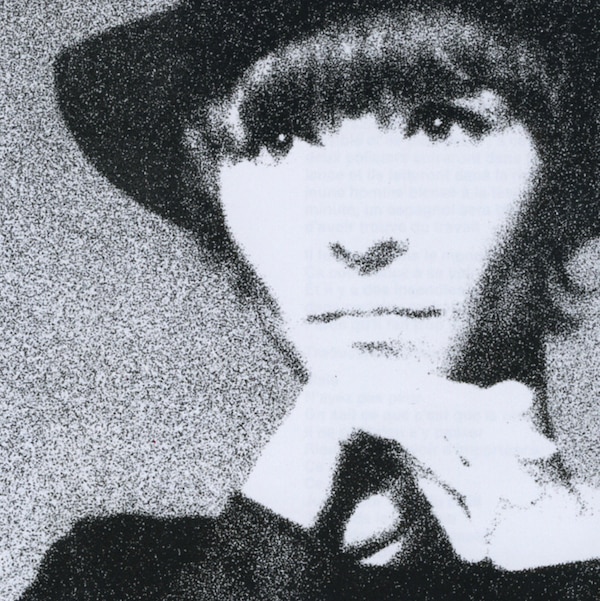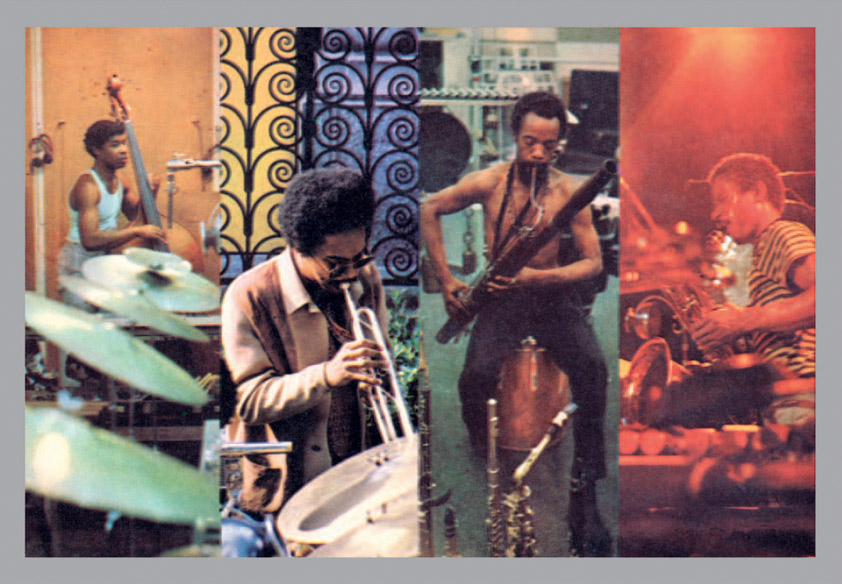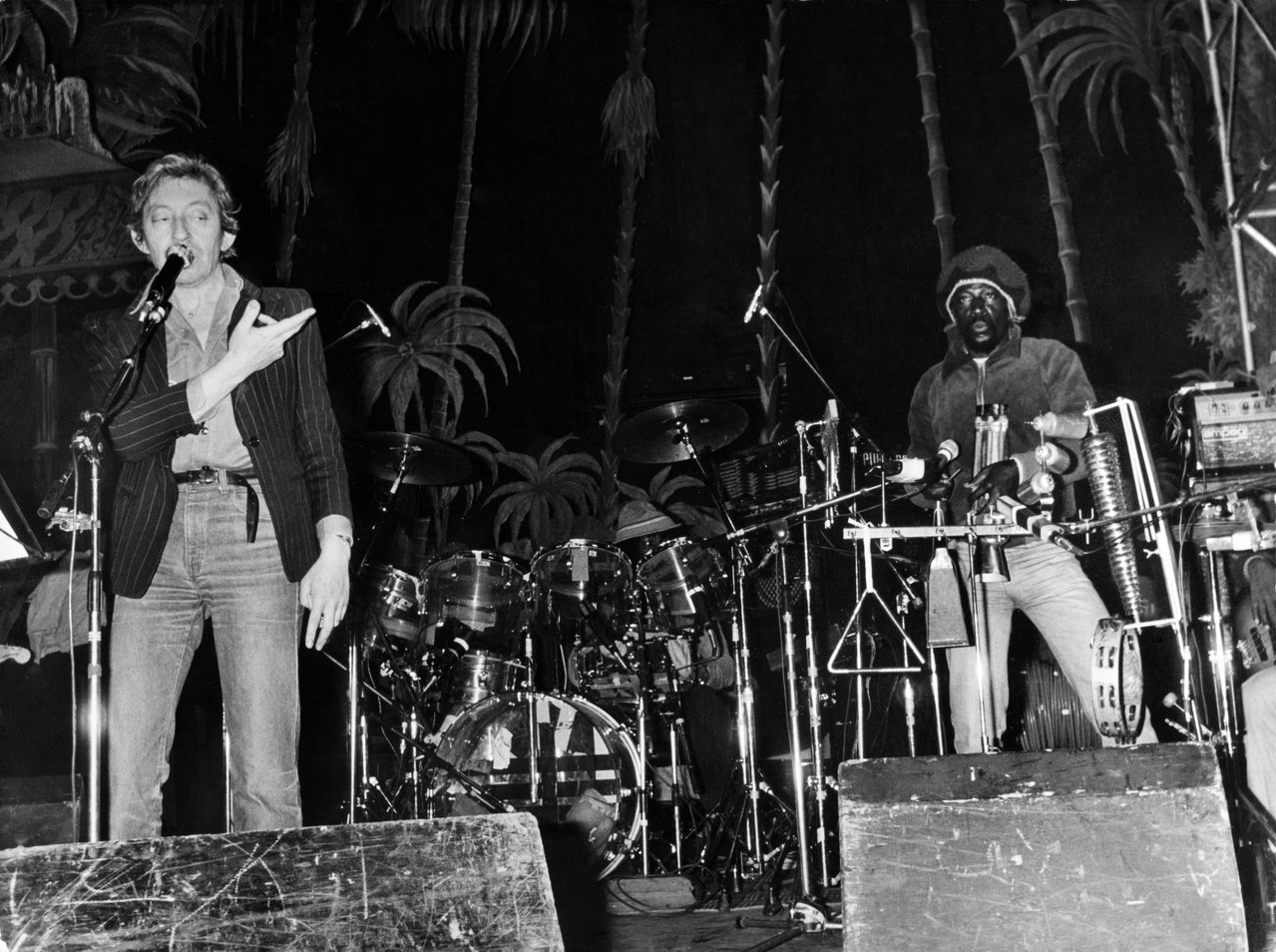Brigitte Fontaine Is...

In 1970, the French singer worked with the Art Ensemble of Chicago and released one of the most exciting and experimental records ever. Clovis Goux tells the story of how it came to be
In 1969, Brigitte Fontaine was invited on Andorra television to perform “Blanche Neige,” one of the key songs of her 1968 album Brigitte Fontaine est... folle11Brigitte Fontaine Is... Mad. To get from Paris to the Principality, she had to change trains at the Latour-de-Carol station, a town with only 359 inhabitants, but one that prided itself on possessing an “international” station boasting three lines, notably marking the beginning of the Cerdagne railway line.
The line majestically traverses the Pyrenees covering about 60 kilometers, its little yellow trains affectionately nicknamed the “canaries.” On the platform, behind the black fringe shrouding half of her pallid face, the singer’s impervious gaze doubtless took in the snowy peaks dominating the station before boarding her connecting train. Back in Paris, she unpacked her luggage and realized that she had somehow misplaced a small red silk jacket. She must have forgotten it at the Latour-de-Carol train station. So she decided to write to the stationmaster to see whether he had found it.
Upon inscribing on the envelope Monsieur le chef de gare de Latour-de-Carol22Mr. Stationmaster of Latour-de-Carol, she felt these few words to be very beautiful, poignant and strange. The poetic dimension she granted them ignited a spark that immediately moved her to write the lyrics of a song. Fittingly, she entitled it “Lettre à Monsieur le Chef de gare de la Tour de Carol”33Letter to the Stationmaster of la Tour de Carol. It was like nothing else around and began:
Mr. Stationmaster
Mr. Stationmaster
Mr. Stationmaster of the Gare de la Tour Carol
You were very pale at seven in the morning
You had creased eyelids
And it mattered to no one in the world
Something that is both terrible and normal
Brigitte Fontaine then entrusted her lyrics to her two collaborators of the period, Jacques Higelin and Areski Belkacem, who were also signed by the Saravah record label that had just released Brigitte Fontaine est… folle. This independent record company proclaimed its libertarian values (May 1968 freshly in mind) with its famous slogan “Some years you feel like doing nothing.” The label had been created four years earlier by Pierre Barouh, a singer, composer, performer and producer, who was then reckoning on the forthcoming success of the film by Claude Lelouch, Un homme et une femme, for which he had composed the soundtrack alongside Francis Lai. Un homme et une femme was well received and won the Palme d’or at Cannes and the Oscar for best foreign film. It became a worldwide phenomenon upon its release in 1966, a hit that allowed Barouh to do exactly as he pleased for some time. The discovery of bossa nova gave him a taste for exoticism, eclecticism and Antipodean music (not yet referred to as world music): Saravah would be a space dedicated to freedom and creativity where strong personalities came together, including Areski, Higelin and Brigitte Fontaine.
Areski Belkacem grew up in Versailles in a Kabyle family. His parents had a restaurant where old Algerian singers regularly played, and when he used to sneak backstage at the Olympia concert venue, he was able to watch rehearsals by Piaf, Brel and The Beatles. Ever since then, he had haunted the cellars of Saint-Germain and the Pigalle clubs, playing drums, before being drafted into the army.
Long before François Villon and up to the present today, popular poets have engaged in the social portraiture of their era. Brigitte is part of this tradition while still retaining a highly personal approach.
During his military service in Germany he came across Jacques Higelin, the son of a music-loving Alsatian railway worker, spotted at the age of 14 by the producer Jacques Canetti. Higelin had been navigating between songs, theater and cinema throughout his life up to that point. Upon being discharged from the army, Areski and Higelin headed for Morocco where they discovered the music and rituals of the Gnawa people. Back in Paris in 1969, they recorded a “strongly influenced by” album for Saravah, simply entitled Higelin et Areski, which focused on monologues laid on minimalist layers of percussion and acoustic guitars. The song “Remember” – closing the album on a tragic note – especially fascinated Brigitte Fontaine. In a monotone voice Jacques Higelin stated:
I will die
In a burning car
The car door won’t open
And I will howl
You’ll learn of my awful
Death
From a friend
In the newspapers or in a letter
Brigitte Fontaine would remember it while she was writing Comme à la radio. At just 30 years old, this teacher’s daughter from Finistère in Brittany already had a couple of careers behind her. She moved to Paris after high school aged 17 to try her luck as an actress, then as a singer performing her own lyrics as an opening act for Georges Brassens, the famed French singer/songwriter and poet, and Barbara, the French chanson singer. Spotted by Jacques Canetti, she recorded two albums of jazzy songs for him, the cruel lyrics making a certain impact in the small world of Saint-Germain-des-Près.
Through her producer, she then met Jacques Higelin, who got her involved, along with the actor Rufus in Maman, j’ai peur44Letter to Mother, I’m Scared, an improvisational play that made light of our innermost anxieties. Its positive reception announced future café théâtre successes. But Brigitte Fontaine would always be closer to the malaise distilled by Zouc-style skits than Café de la Gare schoolboy comedy.
Pierre Barouh first met Brigitte Fontaine at the end of one of her performances, and he became her producer the same day. He wrote of her: “Long before François Villon and up to the present today, popular poets have engaged in the social portraiture of their era. Brigitte is part of this tradition while still retaining a highly personal approach. She is quite an elusive personality with occasional strong paranoid propensities, but the great thing about her is that there is no deviousness in her. She endures these moments, but she manages to play upon this to create something unique.”
Something clicked into place for Fontaine upon meeting Barouh; she had just recorded “Cet enfant que je t’avais fait”55“The Child That I Made You” with Jacques Higelin (its biting humor made Higelin remark: “She’s completely mad to write such things!”). But she wanted to break free from the long shadow cast by Boris Vian and Juliette Greco hovering over her shoulders.
Consequently, the first album recorded for Saravah, composed and arranged by Jean Claude Vannier and Olivier Bloch-Lainé, was highly orchestrated, resolutely pop. The lyrics were deemed unusual and bold. Despite Fontaine’s misgivings, it was entitled Brigitte Fontaine est... folle by Barouh, which would be the beginning of a misunderstanding that has never been dispelled. But instead of interning her in a psychiatric hospital, Fontaine was placed alongside Serge Gainsbourg, an artist she admired but with whom she had a bone to pick in the columns of L’Express magazine: “Gainsbourg is a dandy who creates froth adapted to contemporary tastes without really being personally engaged. He styles himself a cynical spectator of the myths of the period, trendy types, fat lumps, gadgets, money. But he’s not truly against it. I am.”
If May 1968 went right over her head, one year later, Fontaine was a woman rebelling against machismo, the consumerist frenzy gripping the world and social injustices. She committed herself to poetry as others embraced politics. “Lettre à Monsieur le chef de gare de la Tour Carol” was her manifesto. A tract launched in the face of a country that had just elected Georges Pompidou, a modernist President in form but in reality deeply conservative, who would “acclimatize the city to the automobile,” develop intensive agriculture, exploit concrete left, right and center and lead the country into an oil crisis.
Set to music composed by Areski, Fontaine recites “Lettre à Monsieur le chef de gare de la tour Carol” in a somnambulistic voice as though sprung from the depths of the night, while Jean-Charles Capon’s cello, Areski’s percussion and Higelin’s guitar defined a new space in the landscape of French chanson, which owed as much to the use of “talkover” and the influence of the East as a certain magical realism reinterpreted and revised by Fontaine’s prose. Six floating minutes, it was an oddity of a 7-inch single that would anticipate “Comme à la radio” by shattering formats and labels.
But first it would be necessary to make a detour on stage to achieve this. It was at the Lucernaire on Rue d’Odessa in Montparnasse that the Areski, Higelin and Fontaine trio decided to mount Niok, a show sparked by the “happenings,” combining songs, poems, dialogue and improvisations. Le Lucernaire, at the time, was aiming to be a permanent theater venue open to the avant-garde: the Congolese actor Alfred Panou – also signed to Saravah – put on a show called Black Power composed of militant poems; every week Barouh would invite a personality from the world of chanson like Nicole Croisille or Moustaki; Catherine Ribeiro divested herself of her yéyé singer garb to don the apparel of an ardent Marxist.
But most importantly, before Niok, there was a quartet of black American musicians who played music that could not be compared to anything else. Lester Bowie, Roscoe Mitchell, Joseph Jarman and Malachai Favors Maghostut had just left Chicago and moved to Paris, a haven since liberation for all American jazz musicians breaking with tradition and fleeing a country as hostile to their music as the color of their skin. They took the name Art Ensemble of Chicago and intended to free themselves of schools to develop something entirely new.
In concert, they wore boubous and war paint on their faces to celebrate their roots and the hypnotic power of music aimed at trance and awakening. To the traditional line up, they would add many small instruments like a bicycle bell, a steel drum, a djembe or vibraphone. Soon the four musicians got together with Areski, Higelin and Fontaine on stage. All shared the desire to create an art that was a direct expression and decided to extend the experiment to mount a group show.
To this end, the troop would meet in the house where Brigitte Fontaine lived in the village of Autouillet in the Yvelines. Their project involved giving substance to their vision over the course of long improvisations. The première took place in March 1970 on the Theatre du Vieux-Colombier stage: Brigitte Fontaine wore a black hat, vinyl thigh boots and shorts, with the Art Ensemble of Chicago musicians in everyday outfits. They worked with a hodgepodge of instruments thrown on the floor, grabbing them according to their inspiration and Areski’s hypnotic percussion. Together, they would play a brand new repertoire that would soon comprise the album Comme à la radio.
Want to know the difference to pop? When I sing, it’s not a concert or a recital: it’s a drama.
Recorded in spartan fashion in the Saravah studios, the album also deputized the services of Jean-Charles Capon (cello), Jean-François Jenny-Clark (bass), as well as the Tunisian musicians Kanino De Paz (Qanoon) and Albert Guez (lute). The alchemy emanating from the sessions was unique and gave rise to a work of art, which, for the first time, blended free jazz, Arabic music, talkover, French folk and outsider art.
Under the deceptive appearance of a concept album, Comme à la radio proved to be an organic record: each piece, from the minimalist “Tanka 1” and “2” to the long interludes of “Comme à la radio” and “Lettre au chef de gare” opening and close the album, or the interjections – where Fontaine lets fly with phrases like “Mon Dieu, mon Dieu, merci d’avoir inventé Marx, vous étiez pas force” *66My God, my God, thank you for having created Marx, you didn’t have to do it – composes a hallucinatory odyssey that dissects everyday life as though it were a foreign, supernatural phenomenon.
With the slash of a scalpel, Brigitte Fontaine reveals an ordinariness that is suddenly disturbing and threatening. When she turns on her radio, here is the information she transmits to us: “At this moment, thousands of cats are being run over on the roads. At this moment, an alcoholic doctor will swear above the body of a young girl and he will say, ‘She’s not going to die on me, the bitch.’ At this moment, five old ladies in a public park will start debating whether it’s twenty to or five to. At this moment thousands upon thousands of people will think that life is horrible, and they will weep. At this moment two policemen will enter an ambulance and toss a young man with a head wound into the river. At this moment an old lady, dead drunk, will groan alone on the top floor under her bed and move no more. At this moment a Frenchman will be glad to have found a job.”
Alternately pastoral and autobiographical, Comme à la radio had no distinct contours, which is what constituted its power.
Upon the record’s release, interviewed by Le Monde, Fontaine did not go easy on the hippies that many lumped her in with: “What we are doing has nothing to do with their simple and superficial mysticism. ‘Love and peace?’ It’s in bad faith, a complete de-politicization despite appearances. Kindness and optimism are like veneers...” Or with pop music for that matter. “What we call pop music is a kind of hectic monotony, a lullaby perhaps as harmful as Mireille Mathieu. But for other ears. When I hear it, I always feel that jazz was stolen by people who know the price of butter and the art of bluffing.” Before concluding definitively: “What we are doing is not a music-object. In my songs, the lyric is crucial, but it’s useless. Only music can bring it to life: expanses of music and then stuff floating in the music; it always moves around a lot, and then there are gizmos that interfere. Want to know the difference to pop? When I sing, it’s not a concert or a recital: it’s a drama. I like the combinations. If it works, it’s like story telling. If it fails, it looks like a group suicide.”
Hailed by a handful of critics, Comme à la radio was nevertheless a record too far ahead of its time. It was not until the late ’80s that it was finally recognized abroad, notably by Sonic Youth, as a true masterpiece of the 20th century, at last entering the pantheon in France just before Melody Nelson by Vannier and Gainsbourg. But regardless of awards, for Areski and Fontaine, Comme à la radio represented the starting point of a musical adventure and a love. Together, over the course of their albums, they have established a kingdom that belongs solely to them, but is open to all. History does not record whether the stationmaster of Latour-de-Carol ever did find a red jacket on that platform, which had been forgotten by a woman passenger.
Header image © Discogs

